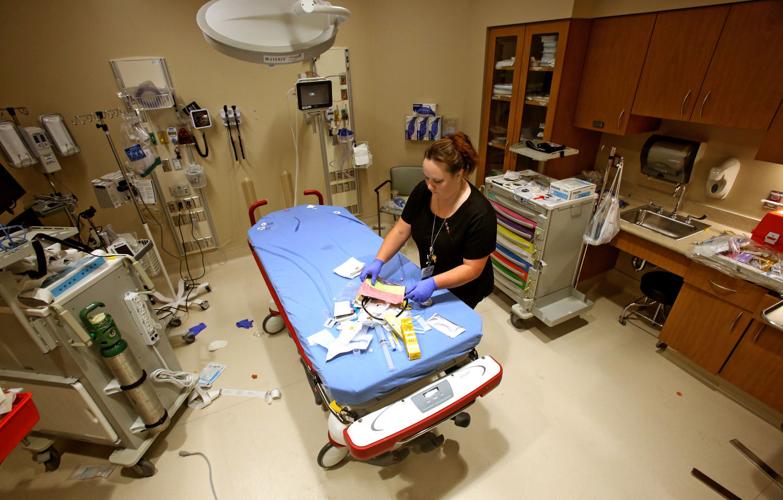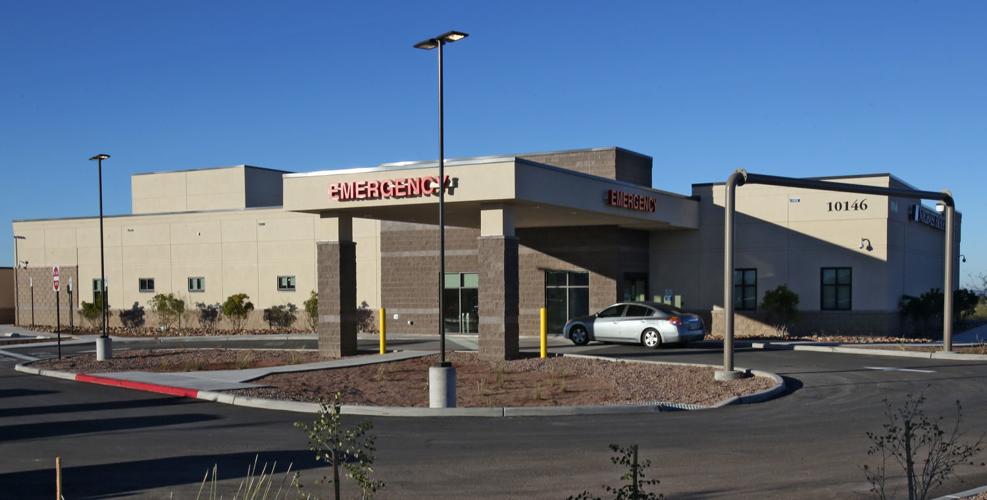The Northwest Emergency Center at Vail, open 24/7, is neither a hospital nor an urgent care.
It is a “freestanding” emergency department — the first of its kind in the Tucson area. Nationally, the number of such facilities has grown rapidly over the last three to five years, fueled by a shortage of primary-care providers, and promises of a more customer-friendly experience than many hospital emergency departments offer.
The $7.2 million Northwest Emergency Center at Vail, which opened in December, is not structurally attached to a hospital. But it is operated by one — Northwest Medical Center, a 300-bed hospital on Tucson’s northwest side that’s owned by Tennessee-based Community Health Systems. Northwest Medical Center also operates urgent-care facilities around town. Though it’s not a traditional emergency department, it is a welcome addition to an area where residents previously had to travel 30 to 40 minutes to a hospital, said Michelle Harrington, executive director of the Greater Vail Area Chamber of Commerce.
There are no urgent-care centers in Vail, either, Harrington said, “so it’s nice to have something closer.”
The Northwest Emergency Center at Vail is at 10146 E. Old Vail Road in Houghton Town Center, at the intersection of Houghton and Old Vail Roads. It was built with an aim of seeing people within a 10-mile radius of its southeast-side location — a service area hospital officials have identified as 33,000 households in Vail, Rita Ranch, Corona de Tucson and surrounding areas.
Increased demand
“Freestanding ERs,” or “freestanding EDs” as they are often called, have no inpatient beds and don’t perform surgery, but supporters say they serve a need, particularly in an area like Vail that has no hospitals in close proximity. The new Vail emergency department has a capacity to see upwards of 100 patients per day. It has 12 private patient rooms with radiology and lab services on-site.
While such facilities date to the 1970s, their numbers have exploded in recent years as emergency visits have increased and emergency departments have closed. The growth has not come without controversy, though, with some saying that such facilities are driving up overall health-care costs by charging emergency prices for routine care.
“Emergency visits to hospitals have been increasing, and now with expansion of Medicaid, more people have access to health care and there’s a critical shortage of primary-care providers,” said Howard Gershon, a Santa Fe, N.M., health-care consultant who has experience with freestanding EDs. “Many hospitals have struggled to provide a customer-friendly environment. The freestanding ED movement has been a response to that and an opportunity for organizations to provide a more-efficient environment than what you find at the hospitals.”
Tucson lost an emergency department in 2012 when the Caron-
delet Health Network closed its Heart and Vascular Institute at 4888 N. Stone Avenue and moved it to be part of its existing St. Mary’s Hospital, 1601 W. St. Mary’s Road.
In a ranking of best to worst rates, Arizona ranks 36th in active primary-care physicians, the Association of American Medical Colleges says. And since January 2014, Arizona’s Medicaid population has spiked 41 percent and is now at 1.8 million enrollees.
Critics cite cost
Freestanding EDs are typically in suburban areas and upscale communities where people have private insurance. Insurance companies don’t always like them, because a visit to an emergency department costs more than getting that same service at an urgent care.
“You typically don’t go to a freestanding ED if you need hospitalization — it’s not place to start,” Gershon said. “The criticism is the patients they are seeing are not critically ill and don’t require all the resources of an ED, but the bill they get is reflective of a fully staffed facility that can take care of critically ill patients.”
A patient can get in and out of an urgent care for roughly $200, whereas in a freestanding ED the cost might be more like $800 to $1,000, Gershon said.
If they aren’t operated by a hospital or hospital system, freestanding EDs can’t bill Medicare or Medicaid. That’s one reason some states have made attempts to limit them. In New Jersey, for example, a freestanding ED can be opened only in an area where a hospital has closed.
But the Northwest Emergency Center at Vail is operated by a hospital, and it accepts Medicare and Medicaid, which in Arizona is called the Arizona Health Care Cost Containment System (AHCCCS). The center also will see pediatric patients.
“The emergency center is open 24/7, unlike most urgent-care facilities, and can treat patients with life-threatening conditions,” Northwest Medical Center spokeswoman Kimberly Chimene said. “We care for patients with heart attack, stroke, head injuries, fractures, abdominal pain, respiratory issues and more — conditions that are typically not treated at urgent-care facilities.”
The physicians and staff at Northwest Emergency Center are prepared to handle urgent-care-level complaints such as fevers and sore throats, too, she said. If a patient needs surgery, he or she would be stabilized and moved to Northwest Medical Center or whichever hospital the patient chooses, Chimene said.
Gershon said some patients want to see a physician, and that’s why they prefer an emergency department.
“That is a cultural issue. Depending on the area, a lot of urgent cares are staffed by nurse practitioners, which some people prefer. Other people really want to see the doctor,” he said.
“A lot of experimentation”
Since there are no inpatient beds in a freestanding ED, if a patient needs to be admitted to a hospital, the center will arrange for transport to one, Chimene said. But she added that the vast majority of patients receiving emergency care are safely discharged to their home, often with outpatient physician follow-up.
“Some conditions that can be managed at a freestanding ED include abdominal pain, treatment of concussion, broken bones, rule out of pulmonary embolism, rule out heart attack, rule out appendicitis, to name just a few,” she said.
Harrington, of the Greater Vail Area Chamber of Commerce, says she’s heard nothing but positive reports from people who have already used the new center.
A freestanding ED is already operating in Glendale in the Phoenix area, but it’s too early to reach a conclusion on the effect of freestanding EDs on health care in Arizona, said Greg Vigdor, president and CEO of the Arizona Hospital and Healthcare Association.
“We’re trying to build a more consumer-sensitive system, and we will have to wait on how the trends play out,” he said. “There’s a lot going on right now to get people help when they need it.”
Indeed, there are walk-in clinics at CVS and Walgreens pharmacies, and some companies like MDLive offer virtual doctor’s visits. Gershon said other physicians are offering after-hours appointments, and some urgent cares are extending hours to 24/7. A company called HealthSpot is trying out kiosks equipped with blood-pressure monitors and other features where patients can have video consultations with physicians. Another company is looking at a model that assumes the patient is at an urgent care, but if the patient needs more services the charges are converted to emergency.
“The growth is because of the critical shortage of primary care,” Gershon said. “There’s a lot of experimentation going on.”
Convenience is the key, and that is what officials are emphasizing in Vail.
“Northwest Emergency Center is committed to expanding emergency services for the area and ensure faster access to care for residents,” Chimene said.
“The center offers a 30-Minute ER Service Pledge, which means we work diligently to have each patient seen by a medical professional — physician, nurse practitioner or physician assistant — within 30 minutes of their arrival to the center.
“For non-life-threatening con-
ditions, patients can check in online at HealthierTucson.com and click on ‘Online Check-In’ to choose a projected treatment time at the Northwest Emergency Center based on the current wait time, and complete a brief online form.”







